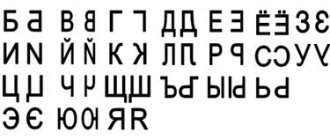Home — About speech therapy — Dyslexia specific reading disorders
Speaking of dyslexia. We mean conditions that are based on a persistent selective inability to master reading skills, despite a sufficient level of intellectual and speech development.
The core disorder in this case is a persistent inability to master syllable fusion and automated reading of whole words, which is often accompanied by a lack of understanding of what is read.
A child suffering from dyslexia, in addition to the above main disorder, has
- Phenomena of emotional-volitional immaturity;
- Has problems with the perception of written/printed information due to disruption of the processes of deployment, sequencing and switching. Doesn't recognize the words, can't understand what exactly he just read.
- Has difficulty developing writing skills, problems with spelling and spelling.
- Disorders of the central nervous system, manifested in behavioral disorders.
- Specific disorders of memory and attention.
Causes of dyslexia
Numerous studies have established that one of the causes of dyslexia is congenital lesions of the central nervous system, including disturbances of activity and attention (hyperactive children), as well as MMD (Minimal Brain Dysfunction).
The next reason is mental retardation (mental retardation).
A very important causal factor is disturbances in the occipital lobe (responsible for organizing complex processes of visual perception) and parietal lobe (responsible for organizing purposeful movements).
Another reason is General underdevelopment of speech (Motor alalia).
And finally, congenital brain pathology. But with it there is a nonspecific reading disorder.
Dyslexia is the most common form of specific learning disorder
1. Ravich-Shcherbo I.V., Maryutina T.M., Grigorenko E.L. Psychogenetics. M.: Aspect Press; 2008.
2. Shaywitz SE, Shaywitz BA Dyslexia (specific reading disability). Biol. Psychiatry. 2005; 57(11): 1301-9. https://doi.org/10.1016/j.biopsych.2005.01.043
3. Morsanyi K., van Bers BMCW, McCormack T., McGourty J. The prevalence of specific learning disorder in mathematics and comorbidity with other developmental disorders in primary school-age children. Br. J. Psychol. 2018; 109(4): 917-40. https://doi.org/10.1111/bjop.12322
4. Peters L., Ansari D. Are specific learning disorders truly specific, and are they disorders? Trends Neurosci. Educ. 2019; 17(100115): 1-8. https://doi.org/10.1016/j.tine.2019.100115
5. Willcutt EG, McGrath LM, Pennington BF, Keenan JM, DeFries JC, Olson RK, et al. Understanding comorbidity between specific learning disabilities. New Dir. Child. Adolesc. Dev. 2019; 2019(165): 91-109. https://doi.org/10.1002/cad.20291
6. McDowell M. Specific learning disability. J. Paediatr. Child. Health. 2018; 54(10): 1077-83. https://doi.org/10.1111/jpc.14168
7. Nachshon O., Farah R., Horowitz-Kraus T. Decreased functional connectivity between the Left Amygdala and Frontal Regions interferes with reading, emotional, and executive functions in children with reading difficulties. Front. Hum. Neurosci. 2020; 14: 104. https://doi.org/10.3389/fnhum.2020.00104
8. Kornev A.N. Reading and writing disorders in children. SPb.: Speech; 2003.
9. Norton ES, Beach SD, Gabrieli JDE Neurobiology of dyslexia. Curr. Opin. Neurobiol. 2015; 30: 73-8. https://doi.org/10.1016/j.conb.2014.09.007
10. Habib M. The neurological basis of developmental dyslexia and related disorders: a reappraisal of the temporal hypothesis, twenty years on. Brain. Sci. 2021; 11(6): 708. https://doi.org/10.3390/brainsci11060708
11. Surushkina S.Yu., Yakovenko E.A., Chutko L.S., Didur M.D. Dyslexia as a multifactorial disorder. Journal of Neurology and Psychiatry. S.S. Korsakov. 2020; 120(7): 142-8. https://doi.org/10.17116/jnevro2020120071142
12. Diagnostic and Statistical Manual of Mental Disorders. Washington: American Psychiatric Association; 2013.
13. Definition of Dyslexia - International Dyslexia Association. Baltimore, MD: International Dyslexia Association; 2011. Available at: https://dyslexiaida.org/definition-of-dyslexia/
14. Zavadenko N.N., Nemkova S.A. Developmental disorders and cognitive dysfunctions in children with diseases of the nervous system. M.: MK; 2016.
15. Luria A.R. Writing and speech: Neurolinguistic research. M.: Academy; 2002.
16. Lalaeva R.I. Reading disorders and ways of their correction in primary schoolchildren. St. Petersburg: Lenizdat; 2002.
17. Richlan F. The functional neuroanatomy of letter-speech sound integration and its relation to brain abnormalities in developmental dyslexia. Front. Hum. Neurosci. 2019; 13: 21. https://doi.org/10.3389/fnhum.2019.00021
18. Valdois S., Reilhac C., Ginestet E., Bosse ML Varieties of cognitive profiles in poor readers: evidence for a vas-impaired subtype. J. Learn. Disabil. 2021; 54(3): 221-33. https://doi.org/10.1177/0022219420961332
19. Lazzaro G., Varuzza C., Costanzo F., Fucà E., Di Vara S., De Matteis M.E., et al. Memory deficits in children with developmental dyslexia: a reading-level and chronological-age matched design. Brain. Sci. 2021; 11(1): 40. https://doi.org/10.3390/brainsci11010040
20. Menghini D., Finzi A., Benassi M., Bolzani R., Facoetti A., Giovagnoli S., et al. Different underlying neurocognitive deficits in developmental dyslexia: a comparative study. Neuropsychol. 2010; 48(4): 863-72. https://doi.org/10.1016/j.neuropsychologia.2009.11.003
21. Bogaerts L., Szmalec A., Hachmann WM, Page MP, Duyck W. Linking memory and language: evidence for a serial-order learning impairment in dyslexia. Res. Dev. Disabil. 2015; 43-44: 106-22. https://doi.org/10.1016/j.ridd.2015.06.012
22. Majerus S., Cowan N. The nature of verbal short-term impairment in dyslexia: the importance of serial order. Front. Psychol. 2016; 7: 1522. https://doi.org/10.3389/fpsyg.2016.01522
23. Cowan N, Hogan TP, Alt M, Green S, Cabbage KL, Brinkley S, et al. Short-term memory in childhood dyslexia: deficient serial order in multiple modalities. Dyslexia. 2017; 23(3): 209-33. https://doi.org/10.1002/dys.1557
24. Simos PG, Fletcher JM, Bergman E, Breier JI, Foorman BR, Castillo EM, et al. Dyslexia-specific brain activation profile becomes normal following successful remedial training. Neurol. 2002; 58(8): 1203-13. https://doi.org/10.1212/wnl.58.8.1203
25. McNorgan C. The connectivity fingerprints of highly-skilled and disordered reading persist across cognitive domains. Front. Comput. Neurosci. 2021; 15: 590093. https://doi.org/10.3389/fncom.2021.590093
26. Randazzo M., Greenspon EB, Booth JR, McNorgan C. Children with reading difficulty relying on unimodal neural processing for phonemic awareness. Front. Hum. Neurosci. 2019; 13: 390. https://doi.org/10.3389/fnhum.2019.00390
27. Morken F., Helland T., Hugdahl K., Specht K. Reading in dyslexia across literacy development: a longitudinal study of effective connectivity. Neuroimage. 2017; 144(Pt. A): 92-100. https://doi.org/10.1016/j.neuroimage.2016.09.060
28. Pugh KR, Mencl WE, Shaywitz BA, Shaywitz SE, Fulbright RK, Constable RT, et al. The angular gyrus in developmental dyslexia: task-specific differences in functional connectivity within posterior cortex. Psychol. Sci. 2000; 11(1): 51-6. https://doi.org/10.1111/1467-9280.00214
29. Horowitz-Kraus T., Vannest JJ, Kadis D., Cicchino N., Wang, YY, Holland SK Reading acceleration training changes brain circuitry in children with reading difficulties. Brain. Behav. 2014; 4(6): 886-902. https://doi.org/10.1002/brb3.281
30. Horowitz-Kraus T., Buck C., Dorrmann D. Altered neural circuits accompany lower performance during narrative comprehension in children with reading difficulties: an fMRI study. Ann. Dyslexia. 2016; 66(3): 301-18. https://doi.org/10.1007/s11881-016-0124-4
31. Horowitz-Kraus T., Holland SK Greater functional connectivity between reading and error-detection regions following training difficulties with the reading acceleration program in children with reading. Ann. Dyslexia. 2015; 65(1): 1-23. https://doi.org/10.1007/s11881-015-0096-9
32. Levinson O., Hershey A., Farah R., Horowitz-Kraus T. Altered functional connectivity of the executive functions network during a Stroop task in children with reading difficulties. Brain. Connect. 2018; 8(8): 516-25. https://doi.org/10.1089/brain.2018.0595
33. Van der Mark S., Klaver P., Bucher K., Maurer U., Schulz E., Brem S., et al. The left occipitotemporal system in reading: disruption of focal fMRI connectivity to left inferior frontal and inferior parietal language areas in children with dyslexia. Neuroim. 2011; 54(3): 2426-36. https://doi.org/10.1016/j.neuroimage.2010.10.002
34. De Jong PF, van den Boer M. The relation of visual attention span with serial and discrete rapid automated naming and reading. J. Exp. Child. Psychol. 2021; 207: 105093. https://doi.org/10.1016/j.jecp.2021.105093
35. Melby-Lervåg M., Lyster SAH, Hulme C. Phonological skills and their role in learning to read: A meta-analytic review. Psychol. Bull. 2012; 138(2): 322-52. https://doi.org/10.1037/a0026744
36. Rakhlin NV, Mourgues C., Cardoso-Martins C., Kornev AN, Grigorenko EL Orthographic processing is a key predictor of reading fluency in good and poor readers in a transparent orthography. Contemp. Educ. Psychol. 2019; 56: 250-61. https://doi.org/10.1016/j.cedpsych.2018.12.002
37. Grigorenko EL Developmental dyslexia: an update on genes, brains and environments. J. Child Psychol. Psychiatr. 2001; 42(1): 91-125.
38. Landerl K, Freudenthaler HH, Heene M, de Jong PF, Desrochers A, Manolitsis G, et al. Phonological awareness and rapid automated naming as longitudinal predictors of reading in five alphabetic orthographies with varying degrees of consistency. Sci. Stud. Read. 2019; 23(3): 220-34. https://doi.org/10.1080/10888438.2018.1510936
39. Powell D., Stainthorp R., Stuart M., Garwood H., Quinlan P. An experimental comparison between rival theories of rapid automated naming performance and its relationship to reading. J. Exp. Child Psychol. 2007; 98(1): 46-68. https://doi.org/10.1016/j.jecp.2007.04.003
40. Araujo S., Pacheco A., Faisca L., Petersson KM, Reis A. Visual rapid naming and phonological abilities: different subtypes in dyslexic children. Int. J. Psychol. 2010; 45(6): 443-52. https://doi.org/10.1080/00207594.2010.499949
41. Goswami U. Sensory theories of developmental dyslexia: three challenges for research. Nat. Rev. Neurosci. 2015; 16(1): 43-54. https://doi.org/10.1038/nrn3836
42. Antzaka A., Martin C., Caffarra S., Schlöffel S., Carreiras M., Lallier M. The effect of orthographic depth on letter string processing: the case of visual attention span and rapid automated naming. Reading and Writing. 2018; 31(3): 583-605. https://doi.org/10.1007/s11145-017-9799-0
43. Saksida A., Ianuzzi S., Bogliotti C., Chaix Y., Démonte J.F., Bricout L., et al. Phonological skills, visual attention span and visual stress in developmental dyslexia. Dev. Psychol. 2016; 52(10): 1503-16. https://doi.org/10.1037/dev0000184
44. Peyrin C., Lallier M., Démonet J.F., Pernet C., Baciu M., LeBas J.F., et al. Neural dissociation of phonological and visual attention span disorders in developmental dyslexia: fMRI evidence from two case studies. Brain Lang. 2012; 120(3): 381-94. https://doi.org/10.1016/j.bandl.2011.12.015
45. Chen NT, Zheng M., Connie SH Examining the visual attention span deficit hypothesis in Chinese developmental dyslexia. Reading and Writing. 2019; 32(3): 639-62. https://doi.org/10.1007/s11145-018-9882-1
46. Pennington BF From single to multiple deficit models of developmental disorders. Cognition. 2006; 101(2): 385-413. https://doi.org/10.1016/j.cognition.2006.04.008
47. Davis K., Margolis AE, Thomas L., Huo Z., Marsh R. Amygdala sub-regional functional connectivity predicts anxiety in children with reading disorder. Dev. Sci. 2018; 21(5): e12631. https://doi.org/10.1111/desc.12631
48. Nelson JM, Harwood H. Learning disabilities and anxiety: A meta-analysis. J. Learn. Disabil. 2011; 44(1): 3-17. https://doi.org/10.1177/0022219409359939
49. Thakkar AN, Karande S., Bala N., Sant H., Gogtay NJ, Sholapurwala R. Is anxiety more common in school students with newly diagnosed specific learning disabilities? A cross-sectional questionnaire-based study in Mumbai, Maharashtra, India. J. Postgrad. Med. 2016; 62(1): 12-9. https://doi.org/10.4103/0022-3859
50. Ochsner KN, Gross JJ The cognitive control of emotion. Trends Cogn. Sci. 2005; 9(5): 242-9. https://doi.org/10.1016/j.tics.2005.03.010
51. Etkin A, Klemenhagen KC, Dudman JT, Rogan MT, Hen R, Kandel ER, et al. Individual differences in trait anxiety predict basolateral amygdala response only to unconsciously processed fearful faces. Neuron. 2004; 44(6): 1043-55. https://doi.org/10.1016/j.neuron.2004.12.006
52. Snowling MJ, Melby-Lervåg M. Oral language deficits in familial dyslexia: A meta-analysis and review. Psychol. Bull. 2016; 142(5): 498-545. https://doi.org/10.1037/bul0000037
53. Esmaeeli Z., Lundetrae K., Kyle FE What can parents' self-report of reading difficulties tell us about their children's emergent literacy at school entry? Dyslexia. 2018; 24(1): 84-105. https://doi.org/10.1002/dys.1571
54. Catts HW, Fey ME, Tomblin JB, Zhang X. A longitudinal investigation of reading outcomes in children with language impairments. J. Speech. Lang. Hear. Res. 2002; 45(6):1142-57. https://doi.org/10.1044/1092-4388(2002/093)
55. Zavadenko N.N., Davydova L.A. Neurological disorders and mental development disorders in children born prematurely (with extremely low, very low and low body weight). Journal of Neurology and Psychiatry. S.S. Korsakov. 2019; 119(12): 12-9. https://doi.org/10.17116/jnevro201911912112
56. Guarini A., Bonifacci P., Tobia V., Alessandroni R., Faldella G., Sansavini A. The profile of very preterm children on academic achievement. A cross-population comparison with children with specific learning disorders. Res. Dev. Disabil. 2019; 87: 54-63. https://doi.org/10.1016/j.ridd.2019.02.001
57. Romo ML, McVeigh KH, Jordan P., Stingone JA, Chan PY, Askew GL Birth characteristics of children who used early intervention and special education services in New York City. J. Public Health (Oxf.). 2020; 42(4): e401-11. https://doi.org/10.1093/pubmed/fdz179
58. Francks C., MacPhie IL, Monaco AP The genetic basis of dyslexia. Lancet Neurol. 2002; (8): 483-90. https://doi.org/10.1016/s1474-4422(02)00221-1
59. Hensler BS, Schatschneider C., Taylor J., Wagner RK Behavioral genetic approach to the study of dyslexia. J.Dev. Behav. Pediatr. 2010; 31(7): 525-32. https://doi.org/10.1097/DBP.0b013e3181ee4b70
60. Olson RK, Forsberg H., Gayan J., DeFries JC A behavioral-genetic analysis of reading disabilities and component processes. In: Klein RM, McMullen PA, eds. Converging Methods for Understanding Reading and Dyslexia. Cambridge: MIT Press; 1999: 133-53.
61. Francks C, Fisher SE, Olson RK, Pennington BF, Smith SD, DeFries JC, et al. Fine mapping of the chromosome 2p12-16 dyslexia susceptibility locus: Quantitative association analysis and positional candidate genes SEMA4F and OTX. Psychiatr. Genet. 2002; 12(1): 35-41. https://doi.org/10.1097/00041444-200203000-00005
62. Georgitsi M., Dermitzakis I., Soumelidou E., Bonti E. The polygenic nature and complex genetic architecture of specific learning disorder. Brain Sci. 2021; 11(5): 631. https://doi.org/10.3390/brainsci11050631
63. Shaywitz SE, Fletcher JM, Holahan JM, Shneider AE, Marchione KE, Stuebing KK, et al. Persistence of dyslexia: the Connecticut longitudinal study at adolescence. Pediatrics. 1999; 104(6): 1351-9. https://doi.org/10.1542/peds.104.6.1351
64. Di Ianni M, Wilsher CR, Blank MS, Conners CK, Chase CH, Funkenstein HH, et al. The effects of piracetam in children with dyslexia. J. Clin. Psychopharmacol. 1985; 5(5): 272-8. https://doi.org/10.1097/00004714-198510000-00004
65. Levi G. A study of piracetam in the pharmacological treatment of learning disabilities. In: Bakker D., ed. Child Health and Development, Developmental Dyslexia and Learning Disorders. Volume 5. Basel: Karger; 1987: 129-39.
66. Van Hout A., Giurgea D. The effects of piracetam in dyslexia. Approche Neuropsychol. Apprentice Enfance. 1990; 2(3): 145-52.
67. Wilsher C., Atkins G., Mansfield P. Effect of piracetam on dyslexics' reading ability. J. Learn. Disabil. 1985; 18(1): 19-25. https://doi.org/10.1177/002221948501800105
68. Wilsher CR, Bennett D, Chase CH, Conners CK, Di Ianni M, Feagans L, et al. Piracetam and dyslexia: effects on reading tests. J. Clin. Psychopharmacol. 1987; 7(4): 230-7. https://doi.org/10.1097/00004714-198708000-00004
Symptoms of dyslexia
Like other diseases, dyslexia has a number of characteristic signs, in the presence of which parents should pay special attention and begin to correct the existing disorder.
Be careful if:
- When reading, the child squints slightly, blinks frequently, and rubs his eyes;
- When reading, he brings the text too close to his eyes, closes one eye or turns his head so that one eye does not participate in reading;
- While reading, skips words or even paragraphs;
- While reading or after it, he complains of severe headache and fatigue;
- When writing, lines and words overlap each other, illegible handwriting, often writes words “back to front”;
- Confuses basic geometric shapes - does not remember them, does not identify them.
However, please note that these phenomena may be signs of decreased vision in the baby. Therefore, before contacting a specialist to correct dyslexia, it is necessary to undergo an ophthalmological examination and confirm the absence of vision problems.
Features of work
To implement each direction of correctional work, certain tasks are used. The speech therapist records which sounds the student confuses as he begins to implement the first stage of the process.
It consistently clarifies the pronunciation of the sound. For better assimilation of the image, a visual and tactile analyzer is used. The letter is made from beans, plasticine, sticks, and drawn on the sand.
To make it easier to identify the position of a sound, bird-shaped diagrams are used. A drawn bird, divided into three parts with vertical stripes: the head is the beginning of the word, the body is the middle, the tail is the end.
The second stage is the separation of two similar sounds by ear. To do this, they focus on auditory control skills.
To develop the sensitivity of the visual analyzer, “noisy pictures” are offered. Letters, objects, silhouettes are drawn on them and they are covered with a large number of strokes on top. The student needs to highlight and name everything that is depicted.
The student is offered a plot picture, based on which he comes up with sentences and counts the number of words. A more complex task - a diagram is given for which you need to select a suitable sentence.
At home, you can study using ready-made workbooks. There is a good manual by Oglobina. Mazanova has a good set.
Diagnosis of dyslexia
- It is necessary to identify dyslexia in a child as early as possible. Moreover, as a rule, most parents do not suspect the presence of this problem until the child begins to learn letters in school or kindergarten. Therefore, it is recommended for preventive purposes to examine all children suffering from active and passive speech delay.
- The most important thing is to perform an EEG of the brain
- It is necessary to check the baby's visual acuity and hearing.
- An important component of diagnosis is a thorough medical and psychological examination, with the help of which it is possible to determine the presence of neurological disorders in order to certainly exclude other diseases “masquerading” as dyslexia and to choose the form of education that is preferable for the child in the future.
Pathogenesis
Dyslexia, in accordance with modern concepts, is usually considered as a neurobiological disorder, which is based on dysfunction/underdevelopment of certain areas of the cerebral cortex, mainly the left temporo-parietal region, which is responsible for decoding/sound-letter analysis and the left temporo-occipital region, which is responsible for the process automated recognition of readable words. That is, in individuals with dyslexia, while reading, information is processed in other areas of the brain through alternative adaptive mechanisms.
There are several mechanisms in the formation of dyslexia:
- Impairments of operational-phonological memory - the ability to retain in memory for a short period of time read letters, sounds and syllables (speech segments), as well as their meaning.
- Violation of serial reading (difficulty in remembering a series of characters, their meanings and concepts in general, that is, difficulty in perceiving a whole syllable).
- Insufficient vocabulary, which hinders the adequate development of reading skills.
- Weak ability to automate reading skills, which requires constant repetition of the skill over a long time.
- Slowness in recalling words already known to the child.
- Impaired concentration.
- Asthenia /increased fatigue of the child.
Dyslexia correction
Dyslexia is treated with the help of special educational programs designed to help the child fill existing gaps in reading skills using special techniques taking into account the type of impairment. It is unacceptable to hope that dyslexia will go away “on its own” as the child grows up.
In any case, it should be remembered that dyslexia is not a death sentence. Children suffering from dyslexia can become artists in the future - like Leonardo da Vinci or Walt Disney, actors - like Dustin Hoffman or Quentin Tarantino, scientists - like Albert Einstein, and even writers - like Vladimir Mayakovsky or Hans Christian Andersen! All these great people also once suffered from dyslexia, but managed to solve their problem, and as a result achieved the highest results in their field.
Share:
Find out more about the Center's services and sign up for a consultation or lesson
You can call (812)
640-90-77
, or by filling out the form below.
Areas of work
To overcome the problem, experts use different correction methods. The optimal number of lessons per week is 4 lessons. Work is being done to develop phonemic awareness. The student is taught to distinguish oppositional sounds by ear, and then reinforces this skill in writing and reading.
The difference in the pronunciation of sounds is clarified, and attention is focused on the sensations of articulation. If there are defects in oral speech, they are eliminated. If all sounds are intact, exaggerated articulation is practiced.
Work is underway to develop the skills of analysis and synthesis. Children should be able to identify a sound, a syllable, and draw up a sentence diagram. To practice the skill, tasks involving adding letters and syllables are offered.
A speech therapist helps develop vocabulary, teaches how to form new words, and use them in speech. The skill of oral and written coherent speech is trained.
Dyslexia in its pure form is rare; most often it is associated with a writing disorder. Therefore, work is carried out on both reading and writing.
Eliminating dyslexia requires 2-3 years of regular training. Parents need to constantly train the child, help him, and complete the tasks of the speech therapist. Sometimes you may need the help of a psychologist who will develop HMF.
Prevention
Prevention of this disorder in a child begins from the moment of pregnancy. To do this, a woman must:
- Lead a healthy lifestyle.
- Eat right, eating foods that are healthy for your body and fetus. The diet of pregnant women should be enriched with polyunsaturated fatty acids. Docosahexaenoic acid promotes the physiological course of pregnancy. If fatty sea fish and seafood are included in the diet, or women take fish oil from mid-pregnancy and after childbirth, children have high rates of neuropsychic development, at 2-2.5 years - good speech development and well-developed fine motor skills, and in 4 years – high level of intellectual development.
- Follow the gynecologist's prescriptions if diseases or infections are detected during pregnancy.
- Proper management of childbirth with the exception of injuries during childbirth is of no small importance.
After birth, starting from the first months of life, parents must constantly talk with the baby - communication gives the initial perception of sounds and the creation of images in his memory. When he starts talking, you can come up with songs and fairy tales together, invite the child to continue and finish the fairy tale or story. In preschool age, it is important to develop memory and attention. The child needs to develop thinking, auditory and visual attention. You can develop tactile sensations by writing letters on your back or arm; you can also ask your child to recognize letters from the Alphabet game by touch.
The development of fine motor skills (finger massage, playing with fingers, using strokes and shading) is of no small importance. If sounds are pronounced incorrectly or sentences are constructed incorrectly, you should immediately begin classes with a speech therapist to eliminate general speech underdevelopment and phonetic-phonemic underdevelopment. Correcting these defects will help further improve reading skills. Impaired auditory and visual speech perception often mimic dyslexia, so the child should be examined by an ophthalmologist and ENT doctor.
Brain hemispheres and dyslexia.
Significant progress in the field of studying the neurophysiological (brain) mechanisms of dyslexia is associated with the emergence and development of new methods of neuroimaging of brain functions - positron emission tomography (PET), nuclear magnetic tomography (MRI) and others. These studies made it possible to formulate a whole list of theories about the causes and nature of dyslexia. One of them connects the causes of speech disorders with structural and functional disorders of the functional specialization of the cerebral hemispheres. According to this concept, the functions of the cerebral hemispheres differ, and each hemisphere specializes in relation to a certain set of functions, and one of the most pronounced functional differences is observed in relation to speech - the speech areas of most right-handed people are in the left hemisphere. These are Broca's motor-speech area and Wernicke's sensory-speech area. As is known, damage to these zones, as well as the pathways connecting them, leads to various combinations of motor, sensory and conduction aphasia - a clinical form of speech impairment. PET studies of brain activity in dyslexic adults during various speech tests revealed less activation in the posterior temporal cortex of their left hemisphere (next to Wernicke's area) than in healthy adults of the same age.
Another approach to studying the mechanisms of dyslexia in children and adults is proposed by the so-called asynchronous theory. Its essence is that normally the reading process is ensured by the synchronous work of a large number of different brain systems, providing various stages of the speech act - encoding/decoding of phonemes and graphemes, synthesizing them into verbal units, providing them with motor speech and spelling programs (in which, apparently , the cerebellum specializes), etc. and so on. An important condition for the normal functioning of this speech system is a high degree of synchrony of its subsystems. If this synchrony is disrupted for some reason, which apparently occurs with dyslexia, a more or less specific speech disorder occurs. This point of view can be confirmed by the fact revealed in scientific research that the time of transmission of a speech signal between the hemispheres is increased, which may indicate this kind of desynchronization in the speech systems of the brain.
Classification
The classification is based on violations of certain reading mechanisms, according to which several forms of dyslexia are distinguished:
- Phonemic. It is a consequence of the weak development of the processes of synthesis, analysis and perception of phonetics. With this form, the child rearranges syllables (for example, reads “cat” instead of “tok”). It occurs mainly in primary schoolchildren.
- Semantic. As a rule, semantic dyslexia is a consequence of insufficient development of syllable synthesis, misunderstanding of syntactic connections and poor vocabulary. The child understands the words separately from the text, so he cannot grasp the meaning of what he read.
- Ungrammatical. It consists of errors in composing constructions and is manifested by incorrect use of word endings, tenses and cases (for example, “white cup”).
- Mnestic. Caused by problems correlating letters and sounds/impaired auditory-verbal memory.
- Optical. It is characterized by insufficiently formed visual-spatial representations/associations—the child cannot clearly focus his gaze on the line being read, which disrupts the reading sequence or sees the word backwards or has difficulty writing graphically similar letters (V-Z, D-L, etc.).
- Tactile. Typical for people with low vision who use Braille to read.
At the same time, phonemic/semantic/agrammatic forms of dyslexia are caused by insufficiently formed speech functions, while mnestic/optical/tactile forms are based on immature mental functions.








